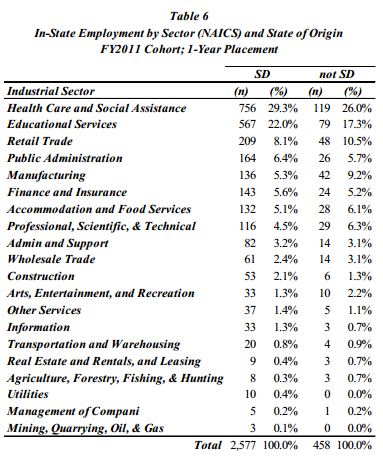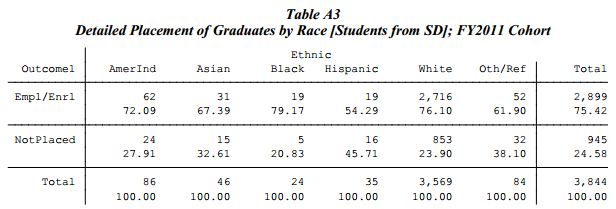I'm reading the report on "Placement Outcomes of Regental Graduates" discussed by the South Dakota Board of Regents at their meeting a couple weeks ago. The report does not address all of the questions blogger Jim Sheehan and I raised about the Regents' contention that the Regental institutions are well-positioned to meet an impending workforce shortage. But it does provide some interesting insights into Regental degree production and job placement... and suggest a direction for meeting South Dakota's educational and workforce needs.
The Regents cite the above data on in-state graduate placement by industrial sector and tout the alignment of big numbers of health care and education graduates and high-demand job areas as a sign of the "university system’s responsiveness to the workforce needs of the state." The Regents cite the state Department of Labor's projections for "high demand occupations," which confirms that health care, social assistance, and education graduates (the two sectors that took the majority of in-state Regental graduate placements in FY2011) will indeed be in increasing demand in South Dakota through this decade.
The DoL lists other high-demand areas like retail, food service, and clerks of all sorts where the Regental placement rates appear to fall behind the DoL's projected demands. And unless there's a big mission change or a Regental takeover of the vo-tech schools, our university graduates won't be filling the growing workforce needs for carpenters, mechanics, drivers, and other skilled labor.
Now the Regents don't claim to be the only solution to workforce needs, and they're not. We need to promote both university and vocational education, as well as do more to recruit and retain qualified teachers and other workers.
At the bottom of the Regents' report, we find one more chart, a breakdown of South Dakota-native graduate placement by race:
Consider the American Indian column of that chart. American Indians make up 8.9% of South Dakota's population; whites, 86.2%. With population growth of 15%, almost twice the growth rate for the entire state over the last decade, Indians have a higher relative youth population. Yet by the numbers above, Indians only comprised 2.2% of the total number of Regental graduates from South Dakota, while white South Dakota natives comprised 92.8%.
The Regents express concern about the decline of young people as a percentage of South Dakota's population. Fewer young people now mean fewer workers. But the relative strength of population growth on the reservations, coupled with endemic reservarion unemployment, suggest that one of the greatest pools of potential South Dakota workers lies right here, in Pine Ridge, Mission, Eagle Butte, and other Indian communities.
Now the Indian graduate numbers are small, so it's hard to derive reliable statistical conclusions, but the FY2011 data show that the Indian graduate placement rate isn't far off from the white graduate placement rate (72% versus 76%). So it appears that if Indians can get to college, they can get the degrees that Regents say the workforce demands.
The logical conclusion here is that any major South Dakota education and workforce initiative should prioritize getting Indians into school and connecting them with the supposedly hard-to-fill jobs in our state. An Indian education/workforce initiative would be no overnight solution: we don't just send a bus to Wanblee, pick up some guys, and drive them to Mitchell to start welding. We need to do more to get our Indian neighbors into quality training and higher education. We need to turn our recruiting focus from out-state back to our own talented people. And we may even need to encourage businesses to locate closer to the reservations to make it easier for them to tap the Indian labor pool.
We could consider a variety of solutions, like 50% or more tuition reduction for all South Dakota tribal members, or moving the Capital University Center to Indian country (Fort Thompson? Martin? Timber Lake?). Unfortunately, the Daugaard Administration is moving in the opposite direction, letting budget skinflintery scuttle College Access scholarships of particular benefit for aspiring Indian youth.
Educating and employing every young tribal member in South Dakota wouldn't fill every new job in the state. But helping every South Dakotan on the reservation get an education and a job should be stapled to the top of any proposal from the Regents to meet South Dakota's workforce needs.



Great read, Cory.
Just curious: if DD has convinced one tribal member/casino manager to be sucked into Pierre should that be sign that every tribal entity can believe everything from the state?
It might be interesting to know how the Dept. of Tribal Government Relations has been received by the tribal nations (other than as a GOP flop) before we believe another word spat by a Daugaardian forked tongue.
I have said many times that I think that there is a huge pool of potential workers on the reservations. For the state and others to not look in those directions shows a complete lack of business savvy. There is a Chamber of Commerce in Kyle, South Dakota that is almost in the center of the Pine Ridge Reservation that could have a huge impact on employment practices in and around that place to name one. Eagle Butte and Mission could do the same, with all three having centers for education in their locations. These are three, there are other centers in the other reservations that could rise to the task as well. I think that if the state of South Dakota could get serious about something like this, it could get legs and work. A few months ago, I would have said a lot of work would be needed to get this going, but after this voting center agreement, I think this could happen if the work was put into it. Nothing beats a failure but a try.
Jerry there are plenty of jobs waiting if the reservations would be willing to change their view of doing business. That part of fixing the problems here would be simple. Just stop wanting to control everything that would threaten the success of a business and there would be all kinds of businesses and jobs.
The Blindman
Dithmer
TYPICAL!
What Rez are you living on Roger?
You fellows shouldn't bash my man Mr. Cornelius. Not everybody can live on a Rez or even get invited to the LNIT. Did you know they don't give some people free or elderly discounts to those games?
Les,
I don't live on a "rez", I was raised and spent many years on the Pine Ridge Reservation, my mother's home. I currently live in Rapid City
Have you attended any of the games yet, Mr. C? I myself hope to hit breakfast one of these last few days and get to the big building where all the goings on of the LNIT are going on. This weekend, nobody lives on a Rez they are all in motels in Rapid City.
grudz,
I haven't attended any of the games yet, but plan to.
There are a conferences held in conjunction with the tourney that I will be attending.
This is a great time for the Lakota and for Rapid City.